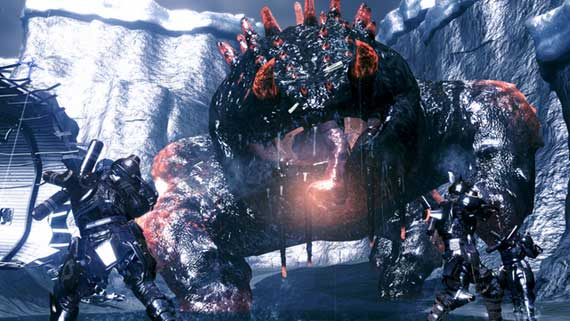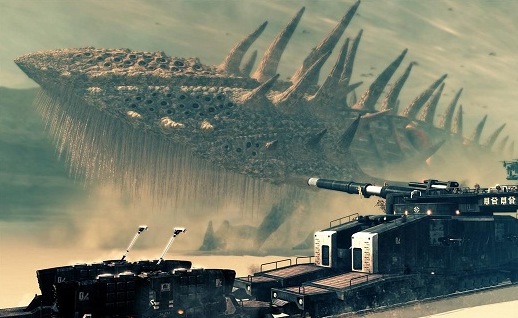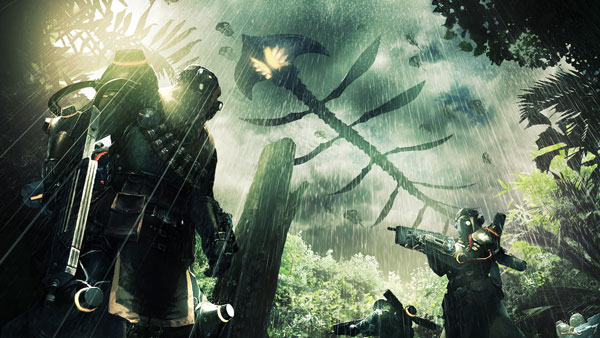I hadn’t played the original Lost Planet so when I started up Lost Planet 2 I didn’t know what to expect. As I explored this game I found that it holds a series of pros and cons that make it an above-average action game at best. The plot is fairly simplistic, with nameless soldiers from several armies (NEVEC, Snow Pirates, Jungle Pirates, Mercenaries, Waysiders and Carpetbaggers) fighting each other or the resident aliens(Akrid) on a planet named E.D.N. III for Thermal Energy, an energy source that is used for a variety of purposes, from powering Vital Suits (resident mechs) to healing. This Thermal Energy constantly drains and must be collected to prevent the ticker from hitting zero, where the player will begin to suffer damage. This apparently made sense in a frozen wasteland that was the setting in the first game, but the same conventions are maintained in Lost Planet 2 despite the fact that most of the missions are in hot or temperate climates.

The armies are more or less the same, other than costume changes, and there is no emotional connection with any of their members; the characters are throwaway avatars for the players as none of them are even named. The campaign is merely an excuse to frame a series of single mission arena fights against NPC opponents and boss battles. There is no character development; the campaign reminded me of fighting game plots, which I suppose is not surprising when you consider that this game was made by Capcom. Each chapter of the game consists of 1-3 missions in which the player and up to 3 others perform simple objectives, such as activating data points on the map that allow respawning and provides a minimap of the area. For several of these missions, it is merely clear enemies, activate beacons, clear a counterattack and complete; there are no other objectives or any deeper goal.

There are exceptions to the rule; in each chapter there are boss battles that belie the poor quality of the rest of the game’s levels. The boss battles are usually titanic in scope, with colossal alien monsters that attack you and roam around the stage pretty much busting stuff up. Each boss has an obvious “SHOOT HERE” target on them, but they bring an element of danger and awe that is missing in many games today. One boss battle has the players fighting an Akrid that acts like a sandworm, diving through a desert in hot pursuit of the train the players are travelling on. It is so massive it could eat the train in a single gulp, so the players must make sure it’s occupied as they travel up the train to their only chance: a massive cannon mounted on the train engine. When actually operating the gun, each player has a part to play as the cannon must be loaded with shells found around the train, energized with T-Energy, and then loaded into a chamber than can hold three shells at once. Once these operations are completed, the gun can fire the shells at the Akrid menace, and then the process repeats. The Akrid is launching little Akrid fighters to harass you during this already fairly intense encounter, and so the added interference really does ratchet up the pressure to kill the Akrid before he blows up the train. The boss battles are a factor that makes the game better than mediocre.
Another element I liked was the presence of the VS Vital Suits, an analogue for the mechanized battle walkers that exist in anime or other games. There are several versions, mainly differing in size: one has just a weapon, another has a shield and weapon, and another can hold two weapons and two players as hangers-on. The VS weapons are massive versions of normal-human sized weapons, but apparently in this incredible world of aliens and battling factions every human is strong enough to carry a gun that is at least as big as they are and swing it around like it was a wiffle bat. The VS’s can exchange weapons for ones lying on the ground, so running out of ammo doesn’t mean having to get rid of the suit. The VS’s add a level of intensity that is not present with the soft weak humans, and allow for jet-assisted leaps and hovers that allow you to fight almost on par with the boss monsters and crush any other enemy in the game. These suits added a unique quality to the game that really made it more fun than your generic third person shooter title.

The graphics are suited to modern gen games, with amazing visuals and smooth animations. It looked fantastic on Directx9 but has full compatibility with D11 so it’s sure to look even better under those circumstances. The interface of the game makes it obvious it is a console port; much like Borderlands, Lost Planet 2 is intended to be played with a group of people, either on a console or over the internet. The lack of emotional investment in the plot means that player interactions are intended to make up most of the entertainment to be had from the game. It’s basically a sandbox that allows players to use and abuse a variety of weapons and armors to kill each other or cooperatively against AI soldiers and aliens. There is little draw or replay value for a single player beyond the impressive boss battles and limited character customization as the majority of the single player game is just a series of arena battles. Overall, Lost Planet 2 could’ve been so much more in every avenue but graphics, but the scope of the game is just too limited to enjoy over a long term or intellectually. It is a decent party game and it lacks the staying power to be anything more than that. LP2 was released on October 12th in North America and October 15th in Europe. It follows the console version that was released in May 2010.